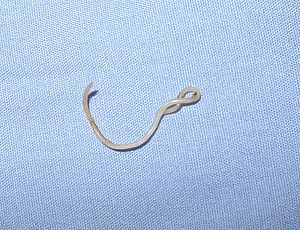Toxocariasis
| Toxocariasis | |
|---|---|
 |
|
| Toxocara canis | |
| Classification and external resources | |
| Specialty | infectious disease |
| ICD-10 | B83.0 (ILDS B83.01) |
| ICD-9-CM | 128.0 |
| DiseasesDB | 29739 |
| eMedicine | med/2293 ped/2270 |
| MeSH | D014120 |
| Toxocara | |
|---|---|
| Scientific classification | |
| Kingdom: | Animalia |
| Phylum: | Nematoda |
| Class: | Secernentea |
| Order: | Ascaridida |
| Family: | Toxocaridae |
| Genus: | Toxocara |
| Species | |
|
Species include: |
|
Toxocariasis is an illness of humans caused by larvae (immature worms) of either the dog roundworm (Toxocara canis), the cat roundworm (Toxocara cati) or the fox roundworm (Toxocara canis). Toxocariasis is often called visceral larva migrans (VLM). Depending on geographic location, degree of eosinophilia, eye and/or pulmonary signs the terms ocular larva migrans (OLM), Weingarten's disease, Frimodt-Møller's syndrome, and eosinophilic pseudoleukemia are applied to toxocariasis. Other terms sometimes or rarely used include nematode ophthalmitis, toxocaral disease, toxocarose, and covert toxocariasis. This zoonotic, helminthic infection is a major cause of blindness and may provoke rheumatic, neurologic, or asthmatic symptoms. Humans normally become infected by ingestion of embryonated eggs (each containing a fully developed larva, L2) from contaminated sources (soil, fresh or unwashed vegetables, or improperly cooked paratenic hosts).
Toxocara canis and Toxocara cati are perhaps the most ubiquitous gastrointestinal worms (helminths) of domestic dogs and cats and foxes. There are many 'accidental' or paratenic hosts including humans, birds, pigs, rodents, goats, monkeys, and rabbits. In paratenic hosts the larvae never mature and remain at the L2 stage.
There are three main syndromes: visceral larva migrans (VLM), which encompasses diseases associated with major organs; covert toxocariasis, which is a milder version of VLM; and ocular larva migrans (OLM), in which pathological effects on the host are restricted to the eye and the optic nerve.
...
Wikipedia
